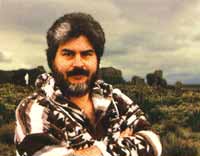Anasazi Liner Notes
Side A: ANASAZI Suite
1. Call Of The Canyon (:19)
2. Anasazi (6:12)
3. Wijiji (2:28)
4. Water Prayer (3:10)
5. Chetro Ketl (4:15)
6. Chaco Twilight (1:40)
7. Summer Solstice (2:26)
8. Shadows On Sandstone (3:50)
9. Sun Dogs (4:50)
Side B: AZTEC Suite
10. Cycles Of Night (4:55)
11. Tenochtitlan (2:27)
12. Tianquiztli (2:42)
13. Stars Over the Pyramid (3:20)
14. The Warrior Awaits (2:50)
15. Tezcatlipoca (3:30)
16. The Great Temple (3:45)
17. People Of The Sun (4:30)
All selections written, performed on electronic keyboards and recorded by Mark C. Petersen.
Copyright 1993, Loch Ness Productions. All rights reserved worldwide. All selections BMI.
Liner notes by Carolyn Collins Petersen.
Cover painting by Mario Sauceda.
Album design by Ellen Kiyler.
Special thanks to the Lakeview Museum Planetarium, Peoria IL, and the Gates Planetarium, Denver CO.

Space Music... from the Dawn of the Second Millennium
Mark C. Petersen and the Geodesium name are synonymous with planetarium space music. For more than 18 years, Mark's music has been heard in the rarefied domain of the planetarium, experienced by those who appreciate the unique offerings of the domed theater — the thrill of all-surrounding visual and all-encompassing aural experiences complemented by a music all its own.
With the fifth album of the Geodesium (pronounced Gee-oh-DEE-zee-um) series, Mark takes his space-based musical stylings into an atmospheric realm of arid deserts, bleached sandstone and ancient temples — a space of another kind, from a time when stars were gods and astronomy was an artform and a religion.
The music on this album was originally composed for two planetarium show soundtracks: The Cosmic Climate Connection, which theorized the disappearance of the Anasazi as a result of changes in their environment, and The Aztec Skywatchers, which explored the culture of the world of Moctezuma.
On the barren high desert plains of northern New Mexico, a spectacular canyon cuts across stark landscapes. Within its sandstone walls lie the ruins of ancient Anasazi cities. This wild and beautiful region, called Chaco Canyon — and the resourceful people who lived here — inspired the music of the Anasazi suite.
An opening flute melody calls across the centuries, setting the scene for music that develops in a chronological pattern of increasing stylistic complexity, winding through Chaco like the life-giving river that once flowed across the canyon floor. It evokes the soul of the Anasazi who made Wijiji and Chetro Ketl their home — adobe cities built between the canyon walls. It forms the spirit of a Chacoan youth, kneeling beside the stream in a quiet moment to give thanks for its precious gifts.
Twilight in the canyon foreshadows the disappearance of the Anasazi, whose long-silent cities today lay crumbling. Summer solstice follows winter just as surely as modern people followed in the footsteps of the departed Anasazi across the desert. Yet, this canyon still calls to the human spirit, though few call it home any longer.
The last piece of the Anasazi suite may seem out of context upon first listening. It repeats the Anasazi themes in a jazz fusion idiom. The listener might perceive these as echoes of the ancient past finding a place in the instruments and music of today. Is the assimilation successful? Does it speak to the hunger of modern culture for a return to the values of the past? Is such a meld of old and new valid and meaningful?
In the end, these are questions we answer for ourselves. The Anasazi — known variously as "the ancient ones" and "the ancient ancestors of the enemy" — are no more, but the artifacts of their culture are gifts to us as we attempt to extract meaning and make our own way through an increasingly complex modern age.
The music of the Aztec suite honors the strength and beauty of Aztec culture, bringing alive the spirit of the ancient peoples who flourished for centuries in great Central Valley of Mexico before encountering the Spanish conquistadors in the early 1500's.
Morning sunrise over Tenochtitlan illuminated a city on an island, a metropolis laid out by the ancient ancestors of the Aztec. Grandeur and tradition was embodied in every structure and its temples soared to the sky, the home of the Aztec deities.
Tianquiztli was the Aztec name for the Pleiades, the seven sacred stars that occupied an important place in the Aztec religion, and the music of the suite creates a sacred soundspace for the Aztec ritual of life, death and rebirth that took place when these stars stood over the ritual pyramid.
The Aztec culture was built on the bravery of its people, and the music depicts the soul of a warrior, waiting in the cool of the early morning for the battle to begin. His bravery is grounded in his belief of life after death with his warrior god Huitzilopochtli.
In the pantheon of Aztec gods, Tezcatlipoca was the silent jaguar who made his way through the undergrowth, sinuous and stealthy — a trickster who came and went like smoke on the wind.
At times of high ritual, processions would snake across the plazas of Tenochtitlan and up the stairs of the Templo Mayor. There, the priests watched the sky and awaited the moment when ritual sacrifice would confirm the Aztec identity as People of the Sun.
GEODESIUM albums by Mark C. Petersen:
Anasazi (1993) CD, cassette
Fourth Universe (1992) CD, cassette
West Of The Galaxy (1987) CD, cassette
Double Eclipse (1981) LP
Geodesium (1977) cassette


